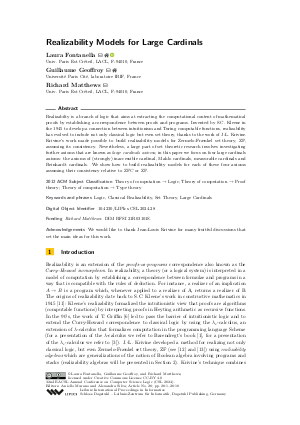Realizability Models for Large Cardinals
Authors
Laura Fontanella  ,
Guillaume Geoffroy,
Richard Matthews
,
Guillaume Geoffroy,
Richard Matthews
-
Part of:
Volume:
32nd EACSL Annual Conference on Computer Science Logic (CSL 2024)
Part of: Series: Leibniz International Proceedings in Informatics (LIPIcs)
Part of: Conference: Computer Science Logic (CSL) - License:
 Creative Commons Attribution 4.0 International license
Creative Commons Attribution 4.0 International license
- Publication Date: 2024-02-07
File

PDF
LIPIcs.CSL.2024.28.pdf
- Filesize: 0.78 MB
- 18 pages
Document Identifiers
Subject Classification
ACM Subject Classification
- Theory of computation → Logic
- Theory of computation → Proof theory
- Theory of computation → Type theory
Keywords
- Logic
- Classical Realizability
- Set Theory
- Large Cardinals
Metrics
- Access Statistics
-
Total Accesses (updated on a weekly basis)
0PDF Downloads0Metadata Views
Abstract
Realizabilty is a branch of logic that aims at extracting the computational content of mathematical proofs by establishing a correspondence between proofs and programs. Invented by S.C. Kleene in the 1945 to develop a connection between intuitionism and Turing computable functions, realizability has evolved to include not only classical logic but even set theory, thanks to the work of J-L. Krivine. Krivine’s work made possible to build realizability models for Zermelo-Frænkel set theory, ZF, assuming its consistency. Nevertheless, a large part of set theoretic research involves investigating further axioms that are known as large cardinals axioms; in this paper we focus on four large cardinals axioms: the axioms of (strongly) inaccessible cardinal, Mahlo cardinals, measurable cardinals and Reinhardt cardinals. We show how to build realizability models for each of these four axioms assuming their consistency relative to ZFC or ZF.
Cite As Get BibTex
Laura Fontanella, Guillaume Geoffroy, and Richard Matthews. Realizability Models for Large Cardinals. In 32nd EACSL Annual Conference on Computer Science Logic (CSL 2024). Leibniz International Proceedings in Informatics (LIPIcs), Volume 288, pp. 28:1-28:18, Schloss Dagstuhl – Leibniz-Zentrum für Informatik (2024)
https://doi.org/10.4230/LIPIcs.CSL.2024.28
BibTex
@InProceedings{fontanella_et_al:LIPIcs.CSL.2024.28,
author = {Fontanella, Laura and Geoffroy, Guillaume and Matthews, Richard},
title = {{Realizability Models for Large Cardinals}},
booktitle = {32nd EACSL Annual Conference on Computer Science Logic (CSL 2024)},
pages = {28:1--28:18},
series = {Leibniz International Proceedings in Informatics (LIPIcs)},
ISBN = {978-3-95977-310-2},
ISSN = {1868-8969},
year = {2024},
volume = {288},
editor = {Murano, Aniello and Silva, Alexandra},
publisher = {Schloss Dagstuhl -- Leibniz-Zentrum f{\"u}r Informatik},
address = {Dagstuhl, Germany},
URL = {https://drops.dagstuhl.de/entities/document/10.4230/LIPIcs.CSL.2024.28},
URN = {urn:nbn:de:0030-drops-196715},
doi = {10.4230/LIPIcs.CSL.2024.28},
annote = {Keywords: Logic, Classical Realizability, Set Theory, Large Cardinals}
}
Author Details
Funding
- Matthews, Richard: DIM RFSI 21R03101S.
Acknowledgements
We would like to thank Jean-Louis Krivine for many fruitful discussions that set the main ideas for this work.
References
-
Hendrik Pieter Barendregt. The lambda calculus - its syntax and semantics, volume 103 of Studies in logic and the foundations of mathematics. North-Holland, 1985.

-
Andreas Blass. Exact functors and measurable cardinals. Pacific journal of mathematics, 63(2):335-346, 1976.

- Matthias Felleisen, Daniel P. Friedman, Eugene E. Kohlbecker, and Bruce F. Duba. A syntactic theory of sequential control. Theor. Comput. Sci., 52:205-237, 1987. URL: https://doi.org/10.1016/0304-3975(87)90109-5.
-
Harvey Friedman. The consistency of classical set theory relative to a set theory with intu1tionistic logic. The Journal of Symbolic Logic, 38(2):315-319, 1973.

-
Harvey Friedman and Andrej Ščedrov. Large sets in intuitionistic set theory. Annals of pure and applied logic, 27(1):1-24, 1984.

-
Timothy G. Griffin. A formulae-as-type notion of control. In Proceedings of the 17th ACM SIGPLAN-SIGACT symposium on Principles of programming languages, pages 47 , 58, 1989.

-
Joel David Hamkins, Greg Kirmayer, and Norman Lewis Perlmutter. Generalizations of the Kunen inconsistency. Annals of Pure and Applied Logic, 163(12):1872-1890, 2012.

-
Yair Hayut and Asaf Karagila. Critical cardinals. Israel journal of mathematics, 236(1):449-472, 2020.

-
Thomas Jech. Set Theory. Springer Monographs in Mathematics. Springer Berlin, Heidelberg, 2003.

-
Akihiro Kanamori. The higher infinite: large cardinals in set theory from their beginnings. Springer Science & Business Media, 2008.

-
Stephen Cole Kleene. On the interpretation of intuitionistic number theory. The Journal of Symbolic Logic, 10(4):109-124, 1945.

-
Jean-Louis Krivine. Typed lambda-calculus in classical Zermelo-Fraenkel set theory. Archive of Mathematical Logic, 40(3):189-205, 2001.

-
Jean-Louis Krivine. Realizability in classical logic. Panoramas et synthéses, Sociètè Mathématique de France, 27:197-229, 2009.

-
Jean-Louis Krivine. Realizability algebras II: new models of ZF+ DC. Logical Methods in Computer Science, 8:1-28, 2012.

-
Jean-Louis Krivine. Realizability algebras III: some examples. Mathematical Structures in Computer Science, 28(1):45-76, 2018.

-
Jean-Louis Krivine. A program for the full axiom of choice. Logical Methods in Computer Science, 17(3):1-22, 2021.

-
Kenneth Kunen. Elementary embeddings and infinitary combinatorics. The Journal of Symbolic Logic, 36(3):407-413, 1971.

-
Azriel Lévy. Axiom schemata of strong infinity in axiomatic set theory. Pacific journal of mathematics, 10(1):223-238, 1960.

- Richard Matthews. A Guide to Krivine Realizability for Set Theory. arxiv preprint, 2023. URL: https://arxiv.org/abs/2307.13563.
-
Elliott Mendelson. Introduction to Mathematical Logic. CRC Press, 5 edition, 2009.

-
Michael Rathjen. Realizing Mahlo set theory in type theory. Archive for Mathematical Logic, 42:89-101, 2003.

-
Anton Setzer. Extending Martin-Löf type theory by one Mahlo universe. Archive for Mathematical Logic, 39(3):155-181, 2000.

-
Akira Suzuki. No elementary embedding from V into V is definable from parameters. The Journal of Symbolic Logic, 64(4):1591-1594, 1999.

-
Neil H. Williams. On Grothendieck universes. Compositio Mathematicae, 21(1):1-3, 1969.

